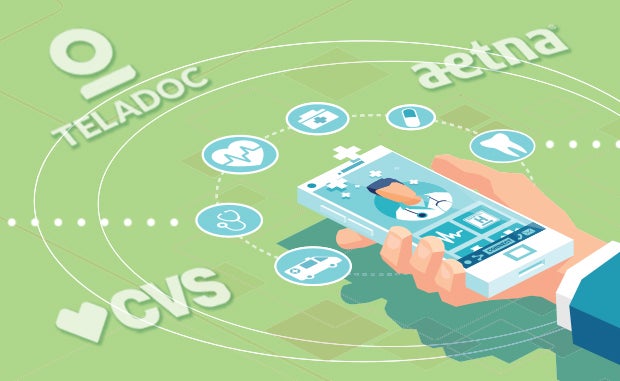

3 Things We Learned from the HIMSS Global Conference

The recent Healthcare Information and Management Systems Society (HIMSS) Global Conference gave tech firms, pharmacy retailers and provider organizations a chance to share insights about digital advances and how they may impact future health care delivery. Here’s what caught our attention during last week’s event.
Aetna Virtual Primary Care Plan Goes Nationwide with $0 Co-pays
 Joining an ever-growing list of retailers and payers aiming to make it easier and cheaper for consumers to access primary care services, Aetna used the HIMSS conference to announce that it is launching a nationwide virtual care program Jan. 1 for self-funded employers.
Joining an ever-growing list of retailers and payers aiming to make it easier and cheaper for consumers to access primary care services, Aetna used the HIMSS conference to announce that it is launching a nationwide virtual care program Jan. 1 for self-funded employers.
Aetna Virtual Primary Care members will be able to access Teladoc Health’s physicians anytime, anywhere as well as services offered by CVS Health. Aetna, a CVS Health company, will offer $0 co-pays for virtual primary care visits and select in-person visits conducted at CVS MinuteClinic and HealthHUB locations.
In what appears to be a unique feature of the service, patients will have a continuous relationship with a virtual care physician beginning with the first 30- to 45-minute comprehensive primary care visit and extending to every visit thereafter.
Beyond primary care services, members also will be able to access existing Aetna virtual care offerings like mental health counseling, dermatology services and 24/7 urgent care.
Salesforce’s Health Cloud Strategy Gets an Update
 Recognizing that health care providers increasingly need to manage patients more closely, Salesforce is launching a series of enhancements to its Health Cloud. Among the updates are:
Recognizing that health care providers increasingly need to manage patients more closely, Salesforce is launching a series of enhancements to its Health Cloud. Among the updates are:
- Remote patient monitoring for Health Cloud: The program surfaces data and insights from connected devices directly within a single dashboard to help providers and care coordinators create a personalized connection with patients to better monitor their conditions.
- Intelligent-appointment management: Designed to optimize appointment-scheduling efficiency by suggesting the right appointment for the right patient at the right time, the tool is aimed at reducing no-shows, administrative costs and time spent on calls with a scheduler.
- Medication management: Salesforce says the tool can help health systems, pharmacies, small practices, retail outlets and others manage medication lists regardless of where care is accessed.
These may seem like small advances, but they support Salesforce’s Health Cloud strategy, which is aimed at delivering a better customer experience without getting into back-office tools provided by electronic health records companies. Salesforce also is using its customer data platform to bring data together in Health Cloud to aid clinicians in providing home care.
Among those using the new Health Cloud tools are Penn State Health, Bon Secours Mercy Health and Humana.
Coming Soon: Algorithmic ‘Nutrition Labels’
 For all the potential that artificial intelligence (AI) and machine learning hold for improving health care, lingering concerns remain about the potential for overstating its capabilities and introducing bias, which could widen care disparities.
For all the potential that artificial intelligence (AI) and machine learning hold for improving health care, lingering concerns remain about the potential for overstating its capabilities and introducing bias, which could widen care disparities.
So, what’s the solution? John Halamka, M.D., Mayo Clinic platform president, offered a modest proposal: Be transparent about an algorithm’s development and its suitability for its intended purpose.
The field needs to define how an algorithm’s fitness for purpose is evaluated and share that information with the public, Halamka noted, in the same way that food packaging provides readily available information to consumers. “Shouldn’t we, as a society, demand a nutrition label on our algorithms?” he asked.
Halamka believes a public-private collaboration of government, academia and industry to address this matter is likely to occur soon. Transparency will be crucial to this effort. Mayo Clinic in May demonstrated its transparency in publishing results from a prospective, randomized control trial stratified by race, age and gender of an algorithm it developed.
The algorithm found that an AI-enabled electrocardiogram increased the diagnosis of low ejection fraction in patients with heart disease, according to a Healthcare IT News report. Ejection fraction is a measurement of how much blood the left ventricle pumps out with each contraction. A lower-than-normal ejection fraction can be a sign of heart failure.
Halamka noted that clinicians will be able to access knowledge from a vast number of previously treated patients to provide better care in the future.



